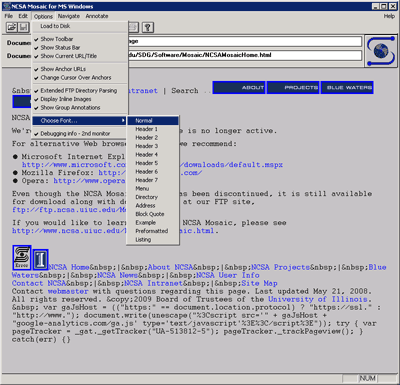NCSA Mosaic Turns 20
 20 years ago today (yesterday), NCSA Mosaic 1.0 was released (read Marc Andreesson’s announcement on www-talk). Mosaic was the browser that opened the web to the masses, making the web more interesting for people like me.
20 years ago today (yesterday), NCSA Mosaic 1.0 was released (read Marc Andreesson’s announcement on www-talk). Mosaic was the browser that opened the web to the masses, making the web more interesting for people like me.
As a college student who used Usenet, FTP sites, struggled with WAIS, Archie and Veronica, and had fallen in love with the ease of Gopher, the web was still just out of arm’s reach for me. With Mosaic came the ability to see pictures directly in the page content — a whole new world for someone used to accessing the internet via only dumb terminals up to that point.
I had forgotten all about it until I saw this tweet from @mattur:
NCSA Mosaic 1.0 released 20 years ago today: 1997.webhistory.org/www.lists/www-… #webhistory
With this post, I’m not bringing anything new to the Mosaic story (at least no more than you get from this three-year-old Wired article on Mosaic), but instead I am taking time to remember that while it may seem like an eternity in web years, it still feels like yesterday that I was downloading Mosaic and trying the web seemingly for the first time.
You can also re-live at least part of this experience.
Download a Copy of Mosaic 1.0
Back when I became an ecommerce developer, less than 4 years after the release of Mosaic, I started an archive of browsers so that I could test the applications I was building in more than just the client’s favorite browser. As time wore on and my collection grew, I created the evolt.org browser archive so that everyone could have access to any browser.
If you want to run NCSA Mosaic 1.0 and relive the early days of the web (even though few pages will render at all), just grab a copy of Mosaic 1.0 from the archive and fire it up. It turns out you don’t need Windows 3.1 to run the Windows version, it will run just fine (mostly) under Windows XP, or in my case a Windows XP virtual machine.
Mosaic Screen Shots
NCSA is kind enough to offer a screen shot of Mosaic 1.0 for Windows so that you can see how awesome it was:

Sadly, that page on the NCSA site doesn’t exist anymore. Visiting it in Mosaic 1.0 today gives you a funny-looking page. The browser uses the Mosaic icon for missing images and the full text of the Google Analytics tracking code is displayed (so they’ll never know I was here):

Even spending a few minutes in Mosaic, unable to surf most sites, will give you some insight into the early days of the web. There was no text styling. If you as a site owner wanted to enforce fonts or colored text, you couldn’t. However, as a user of Mosaic, it was very easy to specify the font styles for different block-level elements within a font menu.
Eagle-eyed readers might notice a “Header 7” option:

Related
If you find this kind of stuff interesting, the W3C has a Web History Community Group where you can help out with the challenge of archiving an incredibly fluid medium, and preserving a little bit of history in the process.
Yep, somebody made a page that tracks Mosaic logo sightings.
As John Allsopp points out, nobody responded to the original email announcing Mosaic 1.0, perhaps setting the tone for browser discussions for years to come:
@brucel @aardrian @evolt_org @mattur there seems to have been no reply on the thread!
Update: April 30, 2013
Just over a week later (from the launch of Mosaic and from the this post), CERN has re-posted its 20-year-old WWW Project site which helped provide everyone with an understanding of HTML so they could make their own sites. I have a write up, with screen captures in Mosaic 1.0, on my blog.
2 Comments
Good times. Worth mentioning that the problem of most sites not working in Mosaic 1.0 is also that it only implements HTTP/1.0, which lacks the Host header. This means that for sites that are hosted as virtual hosts (I'd guess the large majority of sites out there), you'll simply get whatever page was defined as the fallback for the actual physical server itself (in most cases, a very blank page).
One way around this is to set up your internet connection to go via a proxy, which then does the HTTP/1.0 to HTTP/1.1 handling for you.
In response to . Thanks for pointing that out. This applies for nearly any browser from that era, something which I forget every time I fire up my old Netscape.
Leave a Comment or Response